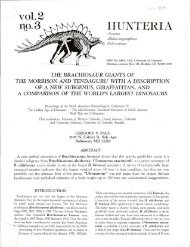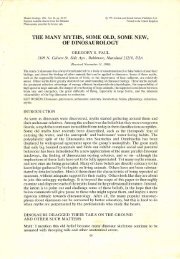Dinosaur models: the good, the bad, and using - Gregory S. Paul
Dinosaur models: the good, the bad, and using - Gregory S. Paul
Dinosaur models: the good, the bad, and using - Gregory S. Paul
Create successful ePaper yourself
Turn your PDF publications into a flip-book with our unique Google optimized e-Paper software.
134<br />
Had <strong>the</strong>re been a large divergence between <strong>the</strong> estimated <strong>and</strong><br />
actual masses, <strong>the</strong> protocol would have been falsified. As it is,<br />
<strong>the</strong> protocol is validated. Also, <strong>the</strong> modem figures can be used<br />
to compare <strong>and</strong> confirm figures <strong>and</strong> mass estimates of extinct<br />
forms.<br />
Error Margins <strong>and</strong> Extrapolating Masses Between Individuals<br />
. Dinofest®>International Proceedings<br />
It is not possible to assign a simple plus or minus margin of<br />
error to a mass estimate derived from an accurately restored<br />
model, but <strong>the</strong> range is probably about ± 15% when <strong>the</strong> skeletal<br />
restoration is not missing any major sections. This is adequate<br />
in view of <strong>the</strong> fact that <strong>the</strong> mass of a nonpregnant adult animal<br />
can vary by a third within a year (especially in temperate regions<br />
where seasonal fat deposits are normal, less so in tropical inhabitants)<br />
<strong>and</strong> as <strong>the</strong>y age (McEwen, et al., 1957; Sinclair, 1977;<br />
Damuth <strong>and</strong> MacFadden, 1990). Estimating <strong>the</strong> mass of a fossil<br />
species is not an exact science.<br />
A model reproduces <strong>the</strong> mass of one individual in one condition,<br />
<strong>and</strong> mass/dimension relationships can vary substantially<br />
within a species, so applying <strong>the</strong> results of any model to o<strong>the</strong>r<br />
individuals should be done with care. Example: sexes often vary<br />
substantially, so it may be necessary to model both when <strong>the</strong>y<br />
are known. The best measure of <strong>the</strong> size of <strong>the</strong> bulky trunk is<br />
<strong>the</strong> length of <strong>the</strong> articulated trunk <strong>and</strong> hip vertebrae, <strong>and</strong> this is<br />
<strong>the</strong> best dimension for extrapolating <strong>the</strong> mass of <strong>the</strong> modeled<br />
individual to o<strong>the</strong>rs in its species or group. Total body length is<br />
less suitable because neck <strong>and</strong> tail length are highly variable<br />
relative to mass in individuals, <strong>and</strong> because consistently measuring<br />
<strong>the</strong> length of <strong>the</strong> often multi-curved spinal column is<br />
difficult. Also, spinal columns are often incomplete in fossils.<br />
Hindlimb elements are more often complete <strong>and</strong> can be substituted<br />
for spinal series when <strong>the</strong> latter are unavailable. The length<br />
of <strong>the</strong> humerus <strong>and</strong> especially <strong>the</strong> long femur are more tightly<br />
correlated with body mass than <strong>the</strong> more distal elements (Damuth<br />
& MacFadden, 1990), so femur length can be used as a<br />
st<strong>and</strong>ard dimension for estimating <strong>the</strong> approximate mass of individuals.<br />
World Record Animals Today <strong>and</strong> in <strong>the</strong> Fossil Record<br />
Among modem wild animals, very rare "world record" 1Ildividuals<br />
are about twice as massive as <strong>the</strong> adult norm (Me-<br />
Farlan & McWhirter, 1989). For example, average African elephants<br />
weigh 3 to 7.5 tonnes, <strong>the</strong> largest bulls on record tip <strong>the</strong><br />
scales at 10 to 12 tonnes. A typical blue whale weighs around<br />
100 tonnes, <strong>the</strong> largest cows may reach 200 tonnes. The populations<br />
of which <strong>the</strong>se giants are a part are very large, in <strong>the</strong><br />
millions. In <strong>the</strong> fossil record <strong>the</strong> number of individual dinosaurs<br />
known from any particular species is much lower, from one to<br />
occasionally a few hundred. Among such small samples', it is<br />
very unlikely that <strong>the</strong> largest individuals represent a typical size<br />
for <strong>the</strong> species. The chance that individuals approaching or<br />
reaching "world record" class will be preserved is virtually nil.<br />
SOME NONDlNOSAURIAN MASS ESTIMATES<br />
The large size of some extinct reptiles, mammals, <strong>and</strong> birds<br />
has elicited attempts to estimate <strong>the</strong>ir mass. A 420 kg mass estimate<br />
of one of <strong>the</strong> largest isl<strong>and</strong> ratites (AppendFig. 3) is in<br />
<strong>good</strong> agreement with past estimates. One of <strong>the</strong> largest continental<br />
reptiles was <strong>the</strong> poorly known giant monitor Megalania<br />
from Australia. A tentative 5.5 m long skeletal restoration (Rich<br />
& Hall, 1979) indicates that megalanians were typical lizards<br />
(long but narrow body, small legs) whose total volume was less<br />
than that of more robust bodied <strong>and</strong> bigger legged l.3 tonne<br />
allosaurs (AppendFig. 5). A model shows that mass was 0.8 to<br />
at most 1.0 tonnes (<strong>using</strong> su<strong>bad</strong>ult komodo monitors as a scaling<br />
data base, Auffenberg [1981] calculated 2.2 tonnes for a 4.5 m<br />
long individual).<br />
Mammoths grew considerably larger than living elephants.<br />
The former tended to have shorter but broader bodies relative<br />
to <strong>the</strong>ir limbs than <strong>the</strong> latter. Many mounted mammoth skeletons<br />
are too tall because <strong>the</strong> shoulder is mounted too low on <strong>the</strong> chest,<br />
<strong>and</strong> claims that known individuals exceeded 4.5 m <strong>and</strong> 15 tonnes<br />
are excessive. The restoration of a nearly complete <strong>and</strong> very<br />
large (3.71 m tall) bull produces a mass estimate of 7.8 tonnes<br />
(AppendFig. 10). The tallest mammoth skeletons represent individuals<br />
a little over 4.0 m <strong>and</strong> 10 to 11 tonnes, about <strong>the</strong> size<br />
of modem world record elephants. World record mammoths<br />
probably approached 20 tonnes.<br />
Bigger still were <strong>the</strong> long limbed indrico<strong>the</strong>re rhinos. The<br />
skeletal restoration is based primarily upon a large juvenile or<br />
adult female (AppendFig. 9; Granger <strong>and</strong> <strong>Gregory</strong>, 1936). Combining<br />
this specimen with o<strong>the</strong>rs (from Osborn, 1923; Borissiak,<br />
1923a,b; Gromova, 1959) allowed <strong>the</strong> trunk <strong>and</strong> limbs to be<br />
accurately restored in all views, except for <strong>the</strong> number of dorsals.<br />
A large skull was scaled down to fit, <strong>and</strong> <strong>the</strong> incomplete<br />
neck was proportioned according to one partial vertebrae relative<br />
to its limb elements, <strong>and</strong> <strong>the</strong> breadth of <strong>the</strong> articulations in dorsal<br />
view. Restored flesh shoulder height is nearly 3.8 m. The biggest<br />
remains (two giant neck vertebrae <strong>and</strong> a partial central metacarpal)<br />
suggest males reached about 4.8 m. The completed restoration<br />
is nei<strong>the</strong>r as heavy in appearance as that published by<br />
Granger & <strong>Gregory</strong>, nor as extremely gracile as <strong>the</strong> Russian<br />
mount (Gromova, 1959). Granger & <strong>Gregory</strong> overscaled most<br />
of <strong>the</strong>ir classic figure (femur <strong>and</strong> vertebral column too long, hip<br />
too large), <strong>and</strong> placed <strong>the</strong> shoulder joint too low on <strong>the</strong> chest,<br />
making it too tall at 5.25 m. The mounted skeleton's errors (neck<br />
too long, pelvis too small, ribs too short, feet <strong>and</strong> humerus too<br />
long relative to femur, limbs too vertical) mainly stem from being<br />
made up of bones from individuals of different size (an<br />
example of <strong>the</strong> failure to cross-scale elements to a common<br />
size!). Because <strong>the</strong> new restoration has a very broad ribcage <strong>and</strong><br />
hips, it is unlikely that <strong>the</strong> volume is too low. Neck musculature<br />
is restored as deep yet narrow, as in o<strong>the</strong>r ungulates. The massive<br />
abdomen is given a simple rhino-like semi-circular lateral<br />
profile. Limb musculature is restored as proximally powerful <strong>and</strong><br />
distally light as per modem flexed limbed ungulates, <strong>using</strong> moderately<br />
fast rhinos, camels <strong>and</strong> workhorses as <strong>models</strong>. Mass for<br />
<strong>the</strong> medium sized specimen is restored as 7.8 tonnes, of which<br />
10% is in <strong>the</strong> head <strong>and</strong> neck. "The similarity in <strong>the</strong> size of <strong>the</strong><br />
bodies of <strong>the</strong> tall rhino <strong>and</strong> <strong>the</strong> mammoth of <strong>the</strong> same mass<br />
confirms <strong>the</strong> accuracy of this result (indrico<strong>the</strong>res also share a<br />
similar mass/shoulder height relationship with proboscideans).<br />
Assuming isometry <strong>the</strong> biggest bulls should have exceeded<br />
about 16.4 tonnes, but this may be somewhat conservative since<br />
ungulates tend to become more massive relative to <strong>the</strong>ir neck<br />
<strong>and</strong> legs as <strong>the</strong>y mature (Damuth & MacFadden, 1990). "World<br />
record" specimens are predicted to have reached 6 m <strong>and</strong> 30<br />
tonnes. The results are in general agreement with <strong>the</strong> bone dimension/mass<br />
scaling calculations of Gingerich (1990) <strong>and</strong> Fortelius<br />
& Kappelman (1993), which offers fur<strong>the</strong>r evidence of <strong>the</strong><br />
accuracy of mass estimates based on technical data. Taken toge<strong>the</strong>r,<br />
<strong>the</strong>se studies also contradict extreme estimates of <strong>the</strong> size<br />
of known specimens. In particular, Alex<strong>and</strong>er's (1989) 34 tonne<br />
mass estimate is too high because <strong>the</strong> trunk length (from Granger<br />
& <strong>Gregory</strong>, 1936) on which he based this estimate is excessive.<br />
The recently extinct giant ape collected in <strong>the</strong> 1930's on a<br />
Indian ocean isl<strong>and</strong> stood 5.5 m tall, <strong>and</strong> is estimated to have<br />
weighed about 7 tonnes.<br />
DINOSAUR MASS ESTIMATES<br />
As in reptiles <strong>and</strong> birds, <strong>the</strong> volume of <strong>the</strong> dinosaur head <strong>and</strong><br />
skull were essentially <strong>the</strong> same because <strong>the</strong>y lacked extensive









